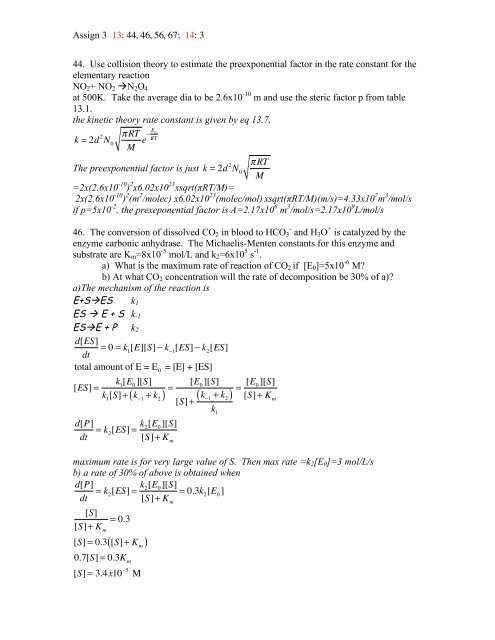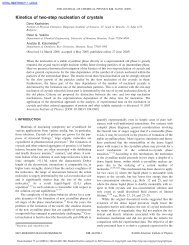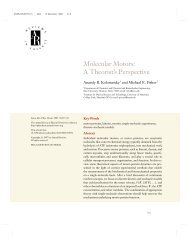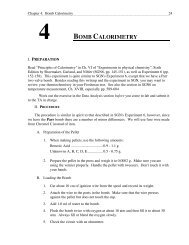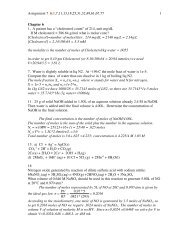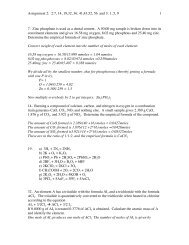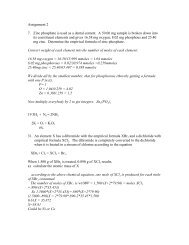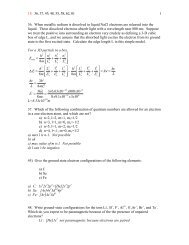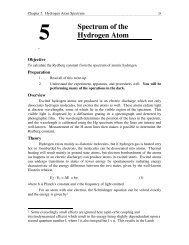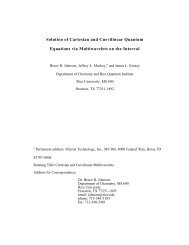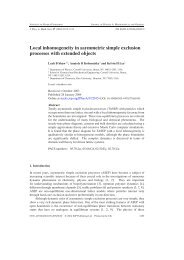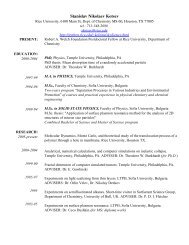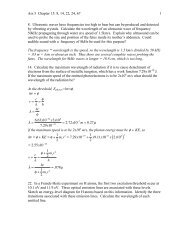3 44. Use collision theory to estimate the preexponential factor in the ...
3 44. Use collision theory to estimate the preexponential factor in the ...
3 44. Use collision theory to estimate the preexponential factor in the ...
You also want an ePaper? Increase the reach of your titles
YUMPU automatically turns print PDFs into web optimized ePapers that Google loves.
Assign 3 13: 44, 46, 56, 67; 14: 3<br />
<strong>44.</strong> <strong>Use</strong> <strong>collision</strong> <strong><strong>the</strong>ory</strong> <strong>to</strong> <strong>estimate</strong> <strong>the</strong> <strong>preexponential</strong> fac<strong>to</strong>r <strong>in</strong> <strong>the</strong> rate constant for <strong>the</strong><br />
elementary reaction<br />
NO 2 + NO 2 N 2 O 4<br />
at 500K. Take <strong>the</strong> average dia <strong>to</strong> be 2.6x10 -10 m and use <strong>the</strong> steric fac<strong>to</strong>r p from table<br />
13.1.<br />
<strong>the</strong> k<strong>in</strong>etic <strong><strong>the</strong>ory</strong> rate constant is given by eq 13.7,<br />
! RT<br />
E<br />
k = 2d 2 a<br />
N 0<br />
M e" RT<br />
! RT<br />
The <strong>preexponential</strong> fac<strong>to</strong>r is just k = 2d 2 N 0<br />
M<br />
=2x(2.6x10 -10 ) 2 x6.02x10 23 xsqrt(πRT/M)=<br />
2x(2.6x10 -10 ) 2 (m 2 /molec) x6.02x10 23 (molec/mol) xsqrt(πRT/M)(m/s)=4.33x10 7 m 3 /mol/s<br />
if p=5x10 -2 , <strong>the</strong> prexeponential fac<strong>to</strong>r is A=2.17x10 6 m 3 /mol/s=2.17x10 9 L/mol/s<br />
46. The conversion of dissolved CO 2 <strong>in</strong> blood <strong>to</strong> HCO - 3 and H 3 O + is catalyzed by <strong>the</strong><br />
enzyme carbonic anhydrase. The Michaelis-Menten constants for this enzyme and<br />
substrate are K m =8x10 -5 mol/L and k 2 =6x10 5 s -1 .<br />
a) What is <strong>the</strong> maximum rate of reaction of CO 2 if [E 0 ]=5x10 -6 M<br />
b) At what CO 2 concentration will <strong>the</strong> rate of decomposition be 30% of a)<br />
a)The mechanism of <strong>the</strong> reaction is<br />
E+SES k 1<br />
ES E + S k -1<br />
ESE + P k 2<br />
d[ES]<br />
= 0 = k 1<br />
[E][S] ! k !1<br />
[ES] ! k 2<br />
[ES]<br />
dt<br />
<strong>to</strong>tal amount of E = E 0<br />
= [E] + [ES]<br />
k<br />
[ES] = 1<br />
[E 0<br />
][S]<br />
k 1<br />
[S] + k !1<br />
+ k 2<br />
d[P]<br />
dt<br />
( ) = [E 0<br />
][S]<br />
( )<br />
= k 2<br />
[ES] = k 2 [E 0 ][S]<br />
[S] + K m<br />
[S] + k !1 + k 2<br />
k 1<br />
= [E 0 ][S]<br />
[S] + K m<br />
maximum rate is for very large value of S. Then max rate =k 2 [E 0 ]=3 mol/L/s<br />
b) a rate of 30% of above is obta<strong>in</strong>ed when<br />
d[P]<br />
dt<br />
= k 2<br />
[ES] = k 2 [E 0 ][S]<br />
[S] + K m<br />
= 0.3k 2<br />
[E 0<br />
]<br />
[S]<br />
[S] + K m<br />
= 0.3<br />
( )<br />
[S] = 0.3 [S] + K m<br />
0.7[S] = 0.3K m<br />
[S] = 3.4x10 !5 M
Assign 3 13: 44, 46, 56, 67; 14: 3<br />
56. For <strong>the</strong> decomposition of N 2 O 5 <strong>the</strong> rate constant is a function of pressure where k eff<br />
as shown below for various <strong>to</strong>tal pressure where N 2 has been added:<br />
P(atm) k eff (s -1 )<br />
9.21 0.265<br />
5.13 0.247<br />
3.16 0.248<br />
3.03 0.223<br />
0.625 0.116<br />
0.579 0.108<br />
0.526 0.104<br />
0.439 0.092<br />
0.395 0.086<br />
<strong>Use</strong> this data <strong>to</strong> <strong>estimate</strong> <strong>the</strong> value of k eff at very high <strong>to</strong>tal pressure and <strong>the</strong> value of k 1 .<br />
Accord<strong>in</strong>g <strong>to</strong> <strong>the</strong> steady state approximation<br />
Rate = k 1 k 2 [M ][N 2 O 5 ]<br />
k 2<br />
+ k !1<br />
[M ]<br />
k eff<br />
= k 1k 2<br />
[M ]<br />
k 2<br />
+ k !1<br />
[M ]<br />
= k eff<br />
[N 2<br />
O 5<br />
]<br />
1<br />
= k + k [M ]<br />
2 !1<br />
1<br />
=<br />
k eff<br />
k 1<br />
k 2<br />
[M ] k 1<br />
[M ] + k !1<br />
k 1<br />
k 2<br />
So a plot of 1/k eff vs 1/[M] should give a st l<strong>in</strong>e with slope of 1/k 1 as shown below<br />
1/k<br />
12<br />
Data 1<br />
y = 3.3161 + 3.3207x R= 0.99889<br />
10<br />
8<br />
1/k<br />
6<br />
4<br />
2<br />
0 0.5 1 1.5 2 2.5 3<br />
1/P<br />
The <strong>in</strong>tercept is 1/k eff <strong>in</strong> <strong>the</strong> limit of high P ≈ 1/3.32 so k eff = 0.30 -1 s -1 and <strong>the</strong> slope is<br />
3.32=1/k 1 so k 1 = 0.3 L/mol/s<br />
67. The gas phase reaction between H 2 and I 2<br />
H 2 + I 2 = 2HI
Assign 3 13: 44, 46, 56, 67; 14: 3<br />
Has kf=240 L/mol/sec and an activation E = 165kJ/mol at 1000K. Us<strong>in</strong>g this and data<br />
from appendix D, calculate Ea and kb for <strong>the</strong> reverse reaction at 1000K, assum<strong>in</strong>g ∆H<br />
and ∆S are temperature <strong>in</strong>dependent.<br />
The activation energies for <strong>the</strong> forward and reverse reactions are related <strong>to</strong> <strong>the</strong> overall<br />
∆E for <strong>the</strong> reaction as shown <strong>in</strong> fig 13.11:<br />
This picture is for a different reaction, but it shows that E a,b =E a,f -∆E. From Appendix D<br />
we have ∆H=+26.48*2-62.44=-9.5 kJ/mol. S<strong>in</strong>ce ∆n=0, ∆E=∆H. Thus E a,b =E a,f -<br />
∆E=165+9.5=174.5.<br />
To calculate k b , we need <strong>the</strong> equilibrium constant K=[HI] 2 /[H 2 ][I 2 ], where ∆G 0 =-RTlnK.<br />
∆G 0 =∆H 0 -T∆S 0 ; ∆H 0 =-9.5 kJ. ∆S 0 =2(206.48)-260.58-130.57 =21.81J/deg<br />
∆G 0 =-9500-1000*21.81=-31.3kJ<br />
K=43=kf/kb so k b =k f /43 = 5.5 L/mol/s. (HI is not very stable stuff!)<br />
14.3 Calculate <strong>the</strong> <strong>to</strong>tal b<strong>in</strong>d<strong>in</strong>g energy <strong>in</strong> kJ/mole and MeV/a<strong>to</strong>m and <strong>the</strong> b<strong>in</strong>d<strong>in</strong>g energy<br />
per nucleon of <strong>the</strong> follow<strong>in</strong>g nuclides, us<strong>in</strong>g data from Table 14.1<br />
a) 40 20<br />
Ca b) 87 37<br />
Rb c) 238 92<br />
U<br />
The b<strong>in</strong>d<strong>in</strong>g energy of Ca is <strong>the</strong> energy released <strong>in</strong> <strong>the</strong> reaction<br />
20 1 1<br />
H + 20 1 0<br />
n = 40 20<br />
Ca<br />
39.9625912 ! 20 *1.0086649158 ! 20 *1.007825032 = !.367u<br />
! m = !931*.367 = !342MeV = !8.55keV / nucleon<br />
The b<strong>in</strong>d<strong>in</strong>g energy of Rb is <strong>the</strong> energy released <strong>in</strong> <strong>the</strong> reaction<br />
37 1 1<br />
H + 50 1 0<br />
n = 87 37<br />
Rb<br />
86.909183 ! 50 *1.0086649158 ! 37 *1.007825032 = !.813u<br />
! m = !931*.813 = !758MeV = !8.71keV / nucleon<br />
The b<strong>in</strong>d<strong>in</strong>g energy of U is <strong>the</strong> energy released <strong>in</strong> <strong>the</strong> reaction<br />
92 1 1<br />
H + 146 1 0<br />
n = 238 92<br />
U<br />
238.050783 ! 146 *1.0086649158 ! 92 *1.007825032 = !1.934u<br />
! m = !931*1.934 = !1802MeV = !7.57MeV / nucleon


